Upwards movement has unfolded overall as expected for this week.
Summary: Overall, now expect a bounce to last about two to a few weeks. For the short term, the last open gap may offer support at 2,685.43.
A primary degree correction should last several weeks and should show up on the weekly and monthly charts. Primary wave 4 may total a Fibonacci 8, 13 or 21 weeks. Look for very strong support about the lower edge of the teal trend channel on the monthly chart.
Primary wave 4 should be expected to exhibit reasonable strength. This is the last multi week to multi month consolidation in this ageing bull market, and it may now begin to take on some characteristics of the bear market waiting in the wings.
The final target for this bull market to end remains at 3,616, which may be met in October 2019.
New updates to this analysis are in bold.
The biggest picture, Grand Super Cycle analysis, is here.
Last published monthly chart is here, video is here.
ELLIOTT WAVE COUNT
WEEKLY CHART
Cycle wave V must complete as a five structure, which should look clear at the weekly chart level and also now at the monthly chart level. It may only be an impulse or ending diagonal. It is clear it is an impulse.
Within cycle wave V, the third waves at all degrees may only subdivide as impulses.
Within primary wave 3, there is perfect alternation and excellent proportion between intermediate waves (2) and (4).
The channel is now drawn about primary degree waves. The first trend line is drawn from the ends of primary waves 1 to 3, then a parallel copy is placed upon the low of primary wave 2. The overshoot of the upper edge of this channel by the end of intermediate wave (3) looks typical. For the S&P, its third waves are usually the strongest portion of an impulse; they often exhibit enough strength to overshoot channels.
Primary wave 4 now has an overshoot on the lower edge of the channel. This is acceptable; fourth waves are not always neatly contained within channels drawn using this technique.
Primary wave 4 may find very strong support about the lower edge of the teal channel, and it looks like this is from where price may be bouncing. This channel is copied over from the monthly chart and contains the entire bull market since its beginning in March 2009. While Super Cycle wave (V) is incomplete, this channel should not be breached at the weekly chart level.
Primary wave 4 may not move into primary wave 1 price territory below 2,111.05.
When primary wave 4 may be complete, then the final target may be also calculated at primary degree. At that stage, the final target may widen to a small zone, or it may change.
At this stage, the expectation is for the final target to be met in October 2019. If price gets up to this target and either the structure is incomplete or price keeps rising through it, then a new higher target would be calculated.
DAILY CHART
Primary wave 4 would most likely end somewhere within the price territory of the fourth wave of one lesser degree. Intermediate wave (4) has its price territory from 2,872.87 to 2,532.69. Within this range sit the 0.236 Fibonacci ratio at 2,717 and the 0.382 Fibonacci ratio at 2,578.
The 0.382 Fibonacci ratio would expect an overshoot of the teal channel. This may be too low; price may find support at the lower edge of the channel. However, as primary wave 4 should be expected to exhibit reasonable strength, it may be able to overshoot the channel and that would look reasonable. This possibility is now more seriously considered.
Primary wave 2 unfolded as a shallow regular flat correction lasting 10 weeks.
The two wave counts are swapped over at the end of this week.
Intermediate wave (A) may be seen as a complete zigzag. A zigzag down to start primary wave 4 may also be labelled intermediate wave (W).
If intermediate wave (A) or (W) subdivide as a zigzag, then primary wave 4 may unfold as a double zigzag, double combination, flat or triangle. Of all these possible structures a flat correction would be least likely as that would not offer structural alternation with the flat correction of primary wave 2.
A double zigzag would also be less likely as that would require a very large overshoot of the teal trend channel, and it would also see a very brief primary wave 4.
A triangle would be fairly likely even though intermediate wave (4) was a triangle. This does not reduce the probability of primary wave 4 also subdividing as a triangle.
A double combination should always be considered if a triangle is possible, and this would also offer reasonable alternation with primary wave 2.
All structural options (except a double zigzag) which begin with a zigzag down would expect a high bounce for intermediate wave (B) or (X). Intermediate wave (B) or (X) would most likely subdivide as a zigzag.
Within a triangle for primary wave 4, intermediate wave (B) would most likely be about 0.8 to 0.85 the length of intermediate wave (A) giving a target range from 2,873.54 to 2,890.38. Intermediate wave (B) of a running triangle may make a new high above the start of intermediate wave (A).
Within a double combination for primary wave 4, intermediate wave (W) may be the first complete structure in a double. Intermediate wave (X) may be a very high bounce and may make a new high above the start of intermediate wave (W). There is no minimum requirement for the length of intermediate wave (X), and no maximum limit
HOURLY CHART
Intermediate wave (B) would most likely subdivide as a single or multiple zigzag to achieve a high bounce. The red daily candlestick for Friday looks like minor wave B may have begun.
If intermediate wave (B) subdivides as a zigzag, then minor wave B may not move beyond the start of minor wave A below 2,604.04.
The gap may remain open, providing support for minor wave B.
Minor wave B may subdivide as any corrective structure. It would most likely be a time consuming sideways correction. It may last a week or more.
ALTERNATE WAVE COUNT
DAILY CHART
It is also possible to see the downwards wave labelled intermediate wave (A) as a complete impulse. If intermediate wave (A) is a five wave structure, then intermediate wave (B) may not move beyond its start above 2,940.91.
Primary wave 4 may be a zigzag to provide structural alternation with the flat correction of primary wave 2; intermediate wave (A) within a zigzag must subdivide as a five wave structure.
Primary wave 4 may not move into primary wave 1 price territory below 2,111.05.
This wave count would expect to see at its end a large overshoot of the teal channel for the end of primary wave C, so that it moves below the end of primary wave A and avoids a truncation. This looks less likely; this is one reason why this wave count today is judged to have a lower probability and is labelled as an alternate.
HOURLY CHART
Intermediate wave (B) may unfold as one of more than 23 possible corrective structures. B waves exhibit the greatest variety in structure and price behaviour. They can be very complicated time consuming sideways corrections, or equally as likely they can be quick sharp zigzags.
To take up time and move price sideways, intermediate wave (B) for this wave count may most likely be a complicated sideways structure such as a flat, combination or triangle. A longer lasting intermediate wave (B) would give primary wave 4 better proportion to primary wave 2 in terms of duration.
Intermediate wave (B) may have begun with a zigzag upwards. If minor wave A subdivides as a three, then intermediate wave (B) may unfold as a flat, combination or triangle.
Minor wave B would most likely be a deep correction, and it may make a new low below the start of minor wave A if intermediate wave (B) unfolds as an expanded flat, running triangle or combination.
TECHNICAL ANALYSIS
WEEKLY CHART
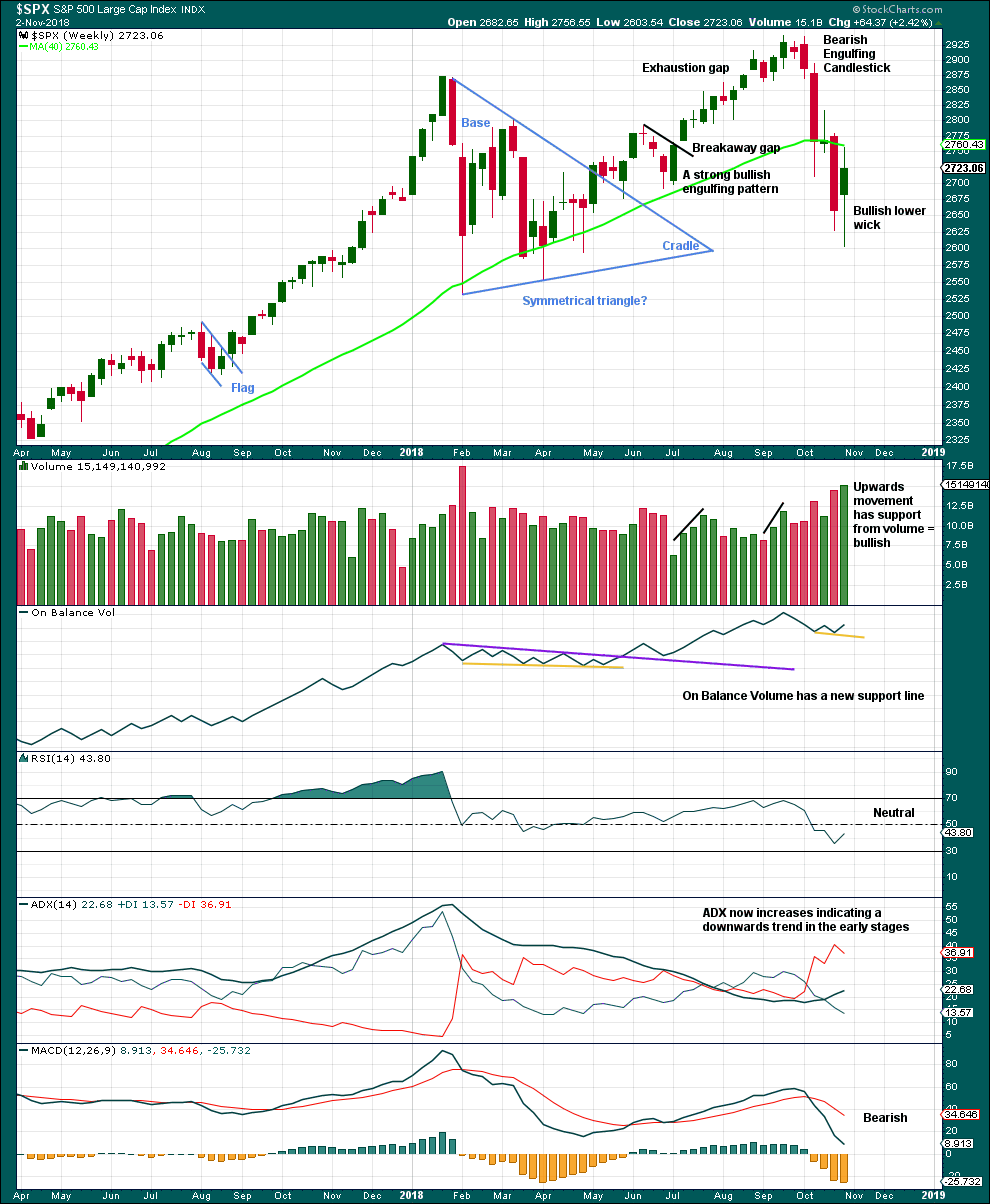
Click chart to enlarge. Chart courtesy of et=”_blank”>StockCharts.com.
Another long lower wick and support from volume this week looks bullish again.
The support line for On Balance Volume is removed and redrawn.
DAILY CHART
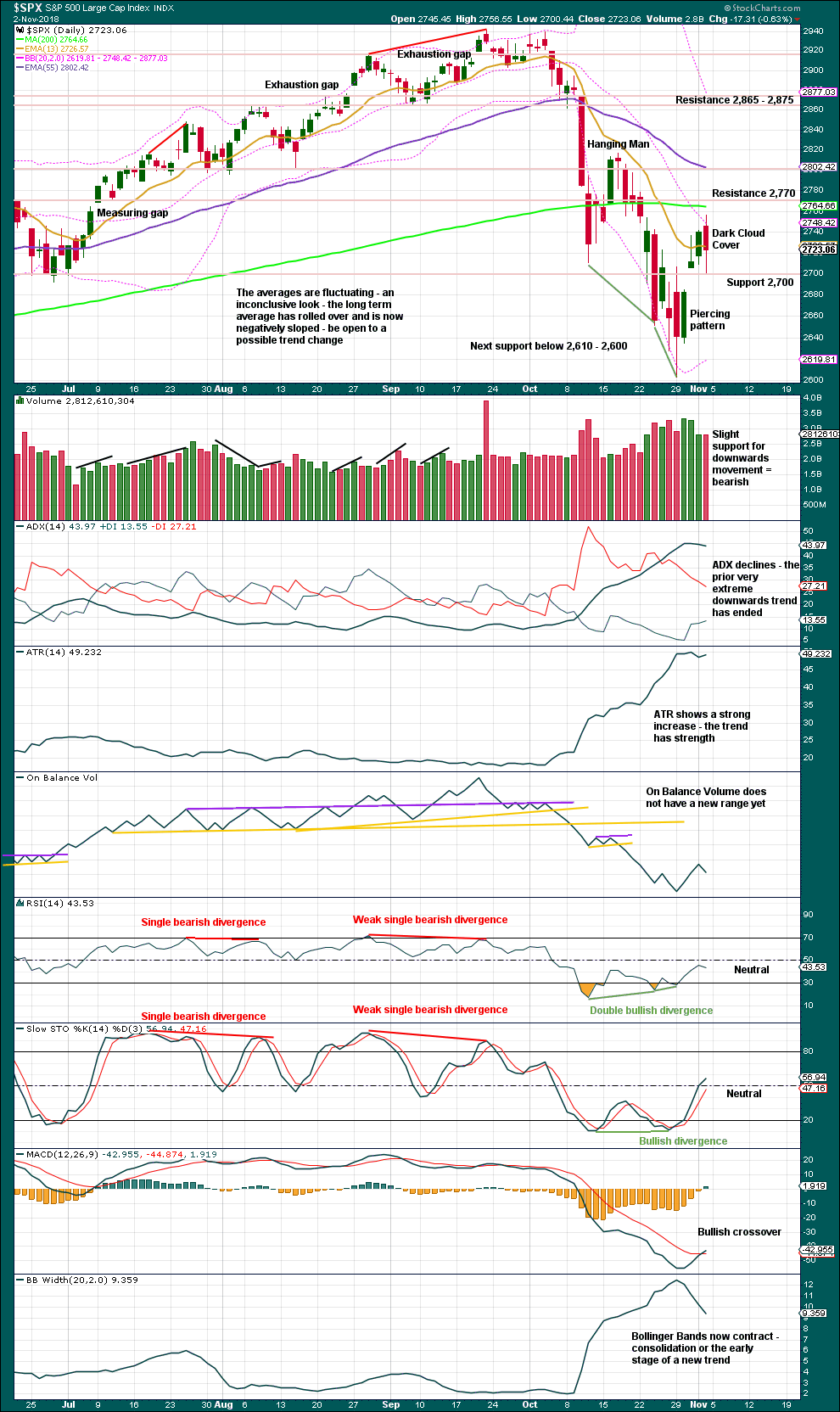
Click chart to enlarge. Chart courtesy of StockCharts.com.
For the short term, expect support about 2,700 and just below that at the last open gap at 2,685.43.
A bearish candlestick reversal pattern and support from volume for a day with the balance of volume downwards suggest next week may begin with more downwards movement. Price may be finding resistance here about the 200 day moving average.
BREADTH – AD LINE
WEEKLY CHART
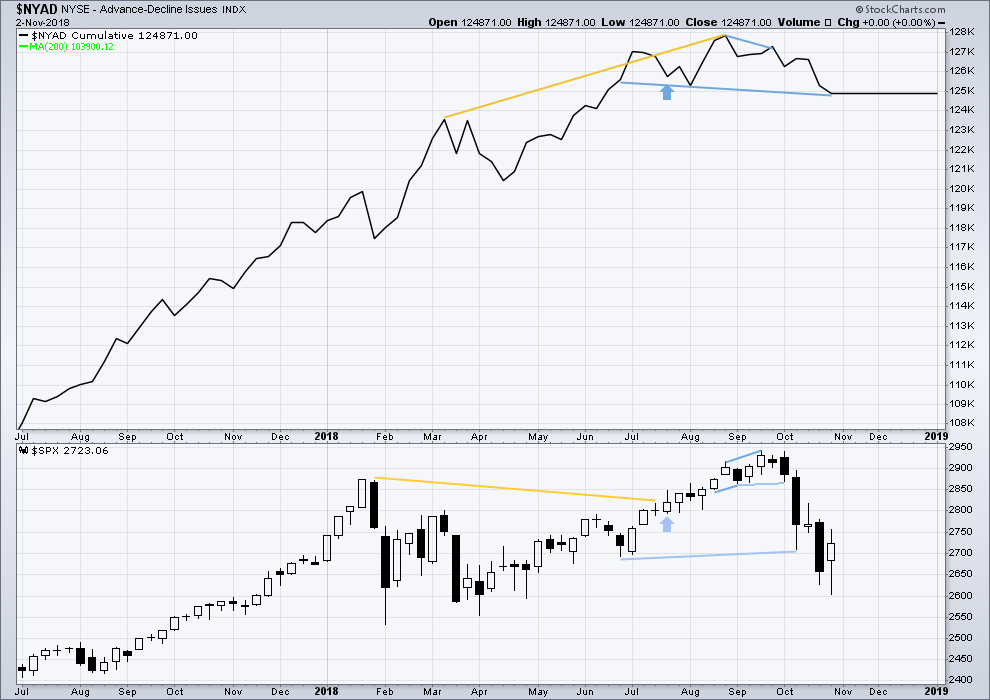
Click chart to enlarge. Chart courtesy of StockCharts.com.
Falling price has support from a decline in market breadth. Breadth is falling in line with price. There is no divergence either way.
DAILY CHART
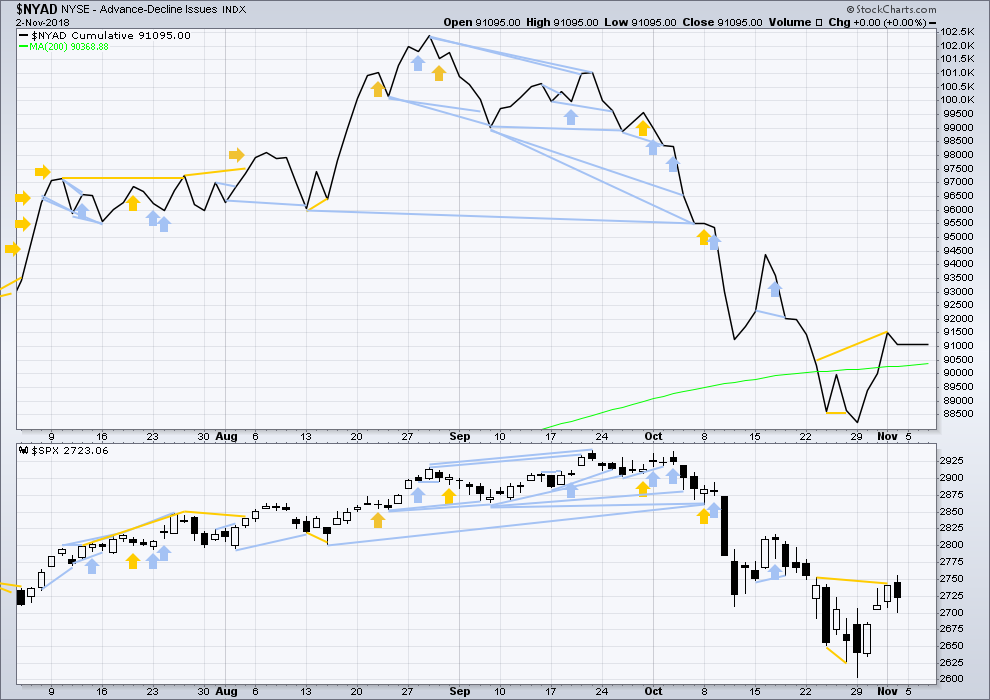
Click chart to enlarge. Chart courtesy of StockCharts.com.
There is normally 4-6 months divergence between price and market breadth prior to a full fledged bear market. This has been so for all major bear markets within the last 90 odd years. With no longer term divergence yet at this point, any decline in price should be expected to be a pullback within an ongoing bull market and not necessarily the start of a bear market. New all time highs from the AD line on the 29th of August means that the beginning of any bear market may be at the end of December 2018, but it may of course be a lot longer than that. My next expectation for the end of this bull market may now be October 2019.
Breadth should be read as a leading indicator.
For Friday price moved mostly sideways and the AD line is flat. There is no new divergence. Most recent divergence remains bullish.
VOLATILITY – INVERTED VIX CHART
WEEKLY CHART
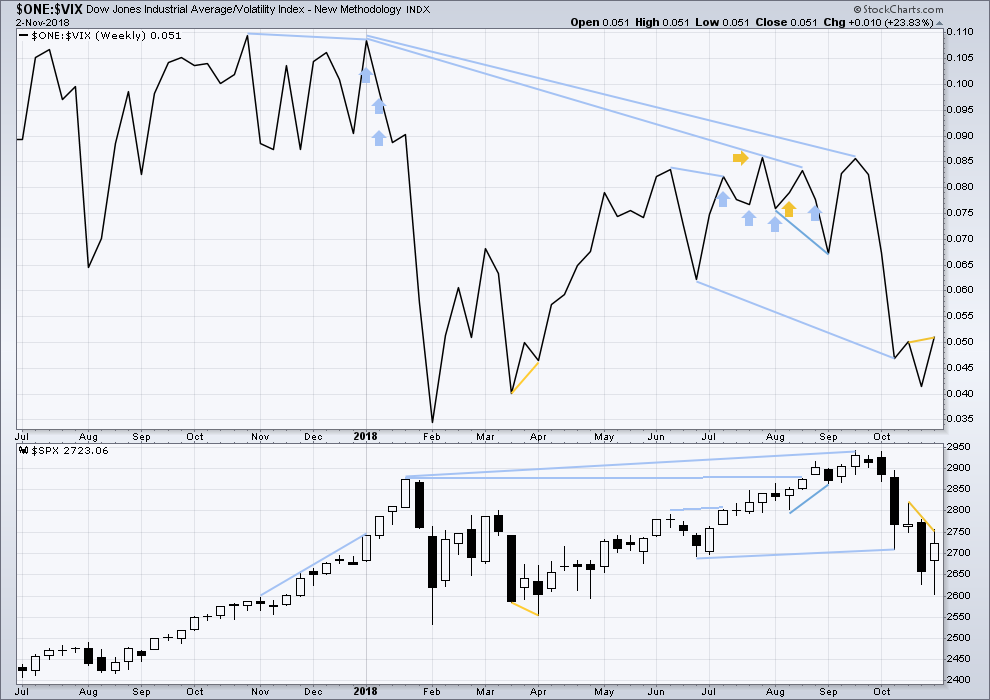
Click chart to enlarge. Chart courtesy of StockCharts.com. So that colour blind members are included, bearish signals
will be noted with blue and bullish signals with yellow.
This week inverted VIX has made a new high above the prior swing high two weeks ago, but price has not. This divergence is bullish.
DAILY CHART
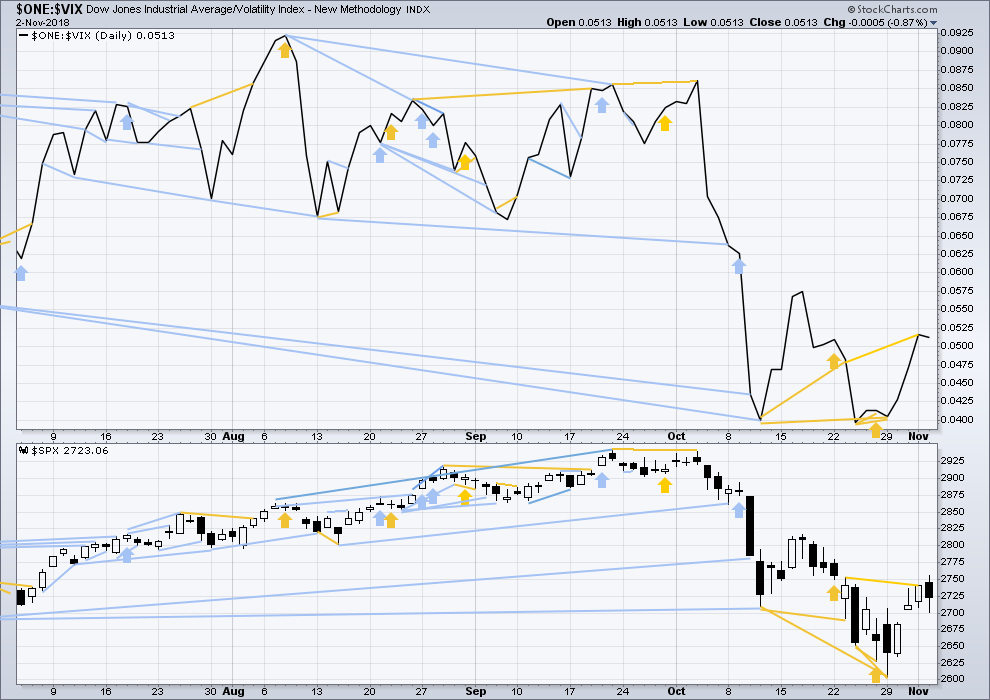
Click chart to enlarge. Chart courtesy of StockCharts.com. So that colour blind members are included, bearish signals
will be noted with blue and bullish signals with yellow.
Normally, volatility should decline as price moves higher and increase as price moves lower. This means that normally inverted VIX should move in the same direction as price.
Downwards movement during Friday’s session has support from a normal slight increase in VIX. There is no new divergence.
DOW THEORY
The following lows need to be exceeded for Dow Theory to confirm the end of the bull market and a change to a bear market:
DJIA: 23,344.52.
DJT: 9,806.79.
S&P500: 2,532.69.
Nasdaq: 6,630.67.
ANALYSIS OF INTERMEDIATE WAVE (4)
TECHNICAL ANALYSIS
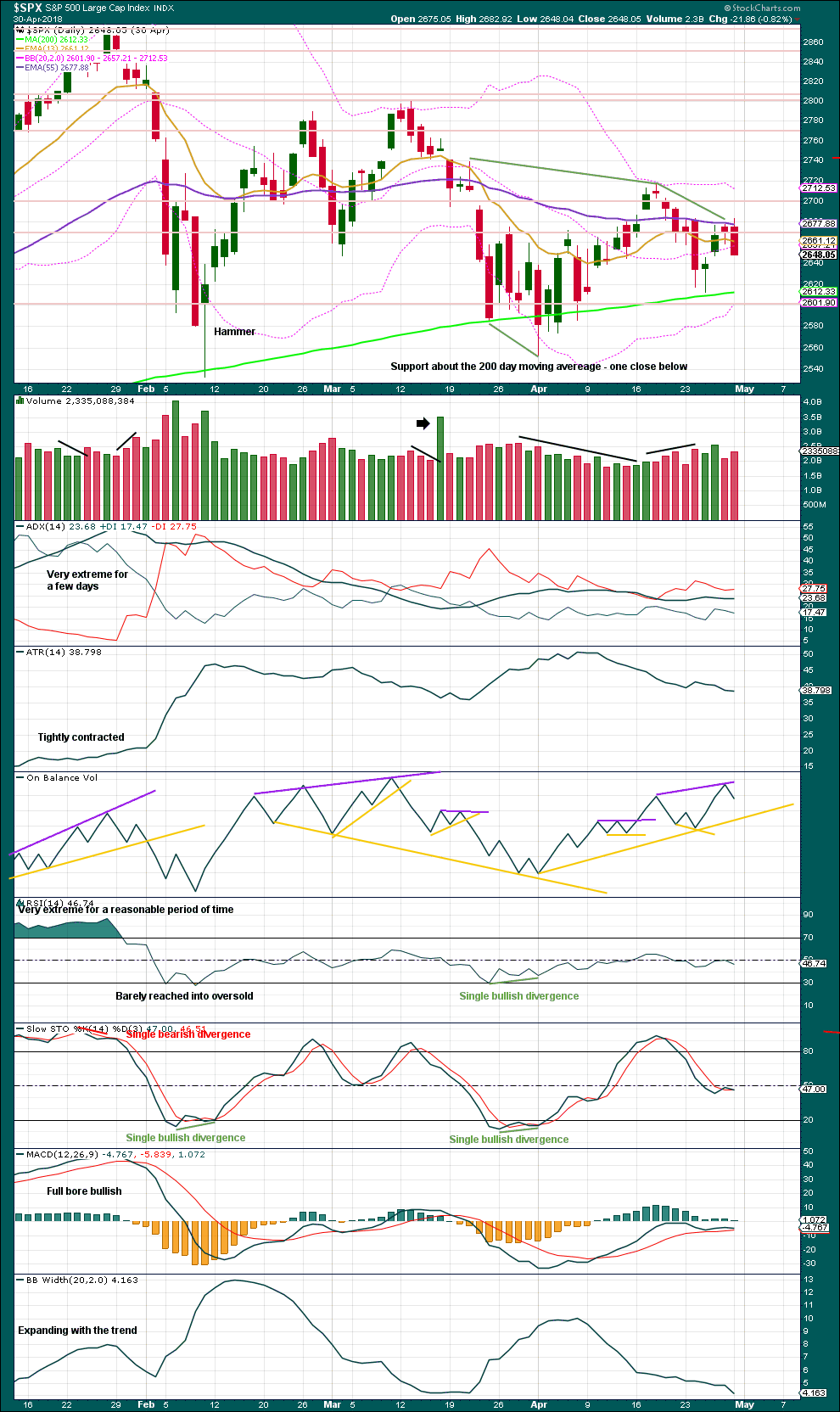
Click chart to enlarge. Chart courtesy of StockCharts.com.
Intermediate wave (4) was a large symmetrical triangle. The deepest wave was the first wave. At its low there was a clear candlestick reversal pattern and bullish divergence between price and Stochastics.
RSI barely managed to reach into oversold.
The current correction for primary wave 4 may behave differently, but there should be some similarities.
It is expected that primary wave 4 may be stronger than intermediate wave (4).
VIX
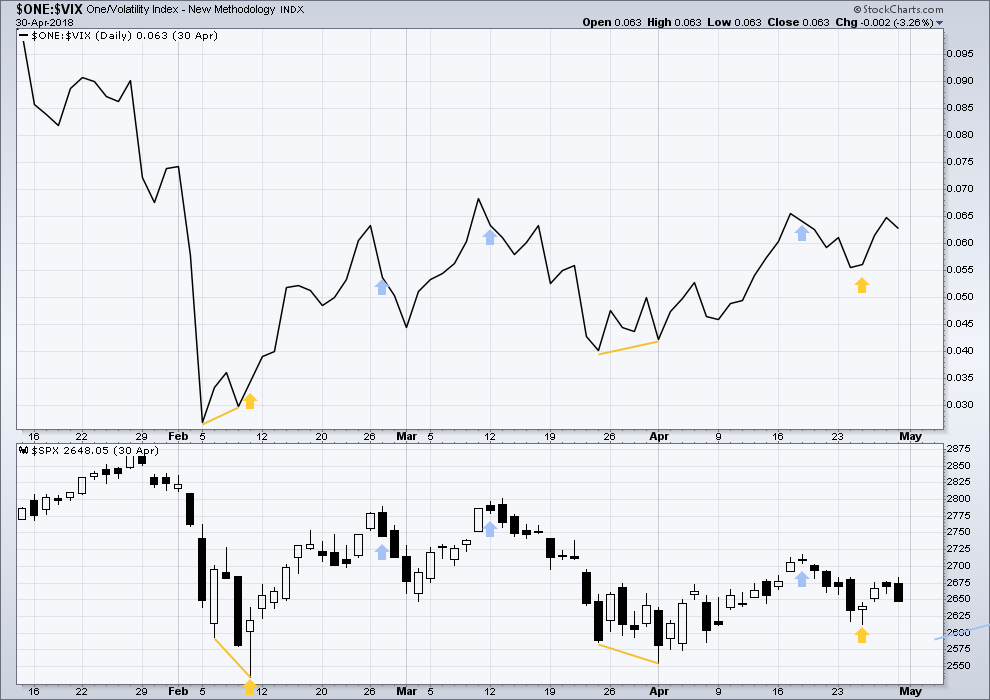
Click chart to enlarge. Chart courtesy of StockCharts.com.
This is a daily chart.
At the two major lows within intermediate wave (4), inverted VIX exhibited single short term bullish divergence.
At highs within intermediate wave (4), inverted VIX exhibited one single day bullish divergence with price.
AD LINE
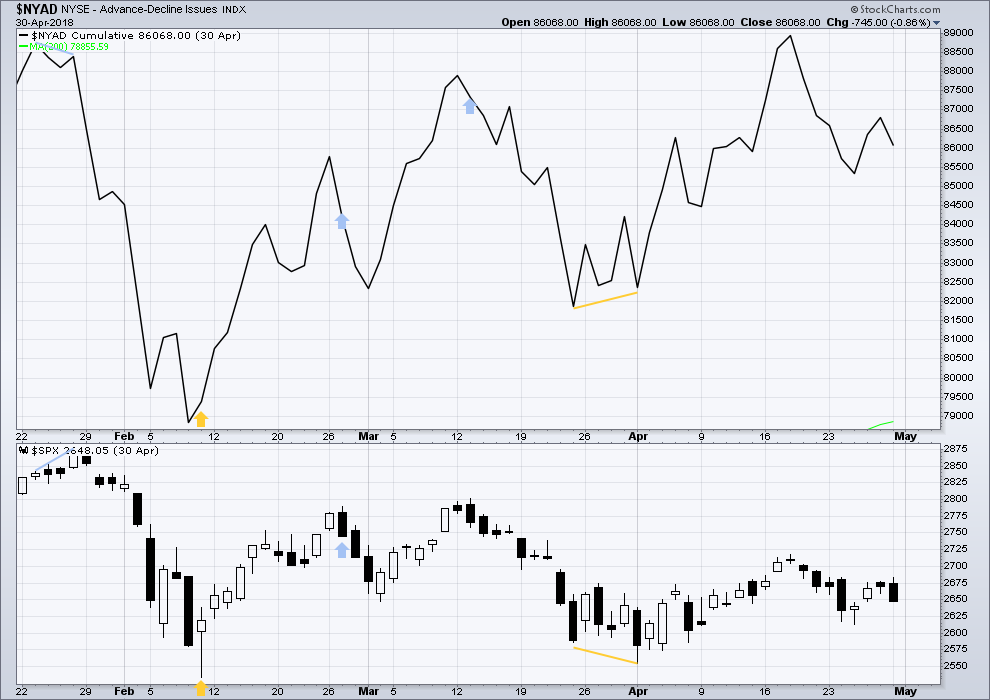
Click chart to enlarge. Chart courtesy of StockCharts.com.
This is a daily chart.
At the two major lows within intermediate wave (4), there was bullish divergence between price and the AD line. At the two major highs within intermediate wave (4), there was each one instance of single day bearish divergence.
Published @ 06:24 p.m. EST on November 3, 2018.
—
Careful risk management protects your trading account(s).
Follow my two Golden Rules:
1. Always trade with stops.
2. Risk only 1-5% of equity on any one trade.

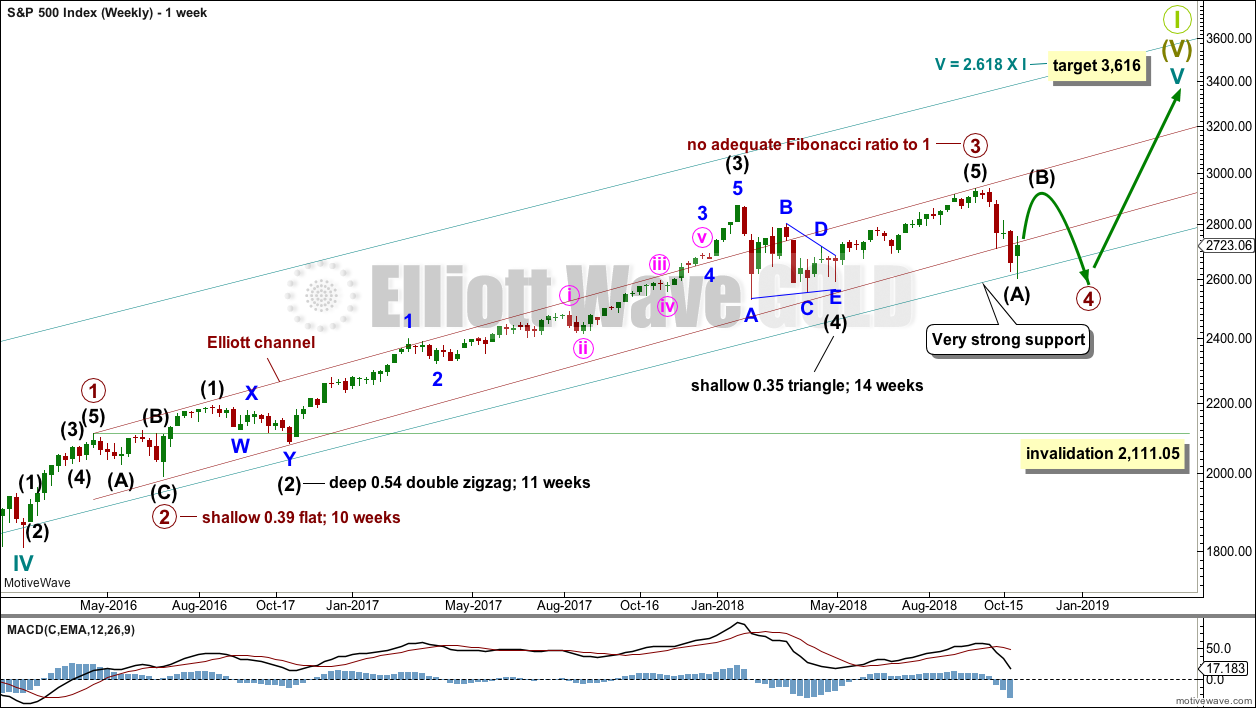
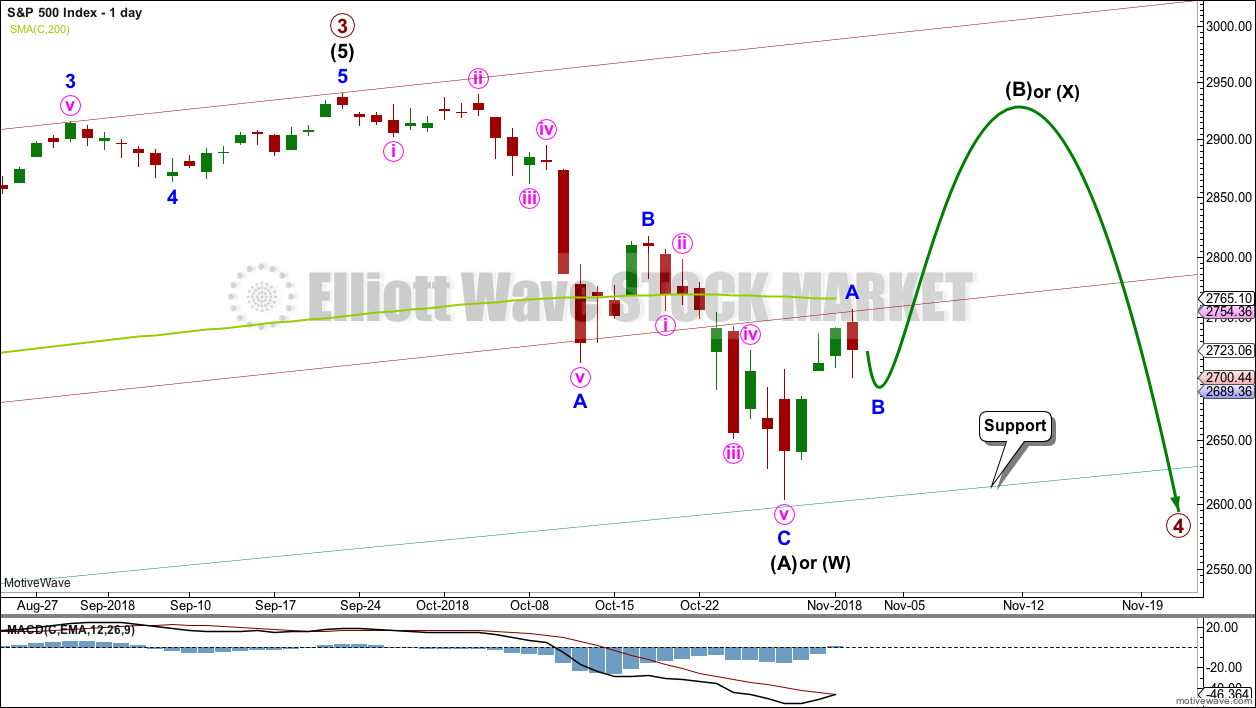
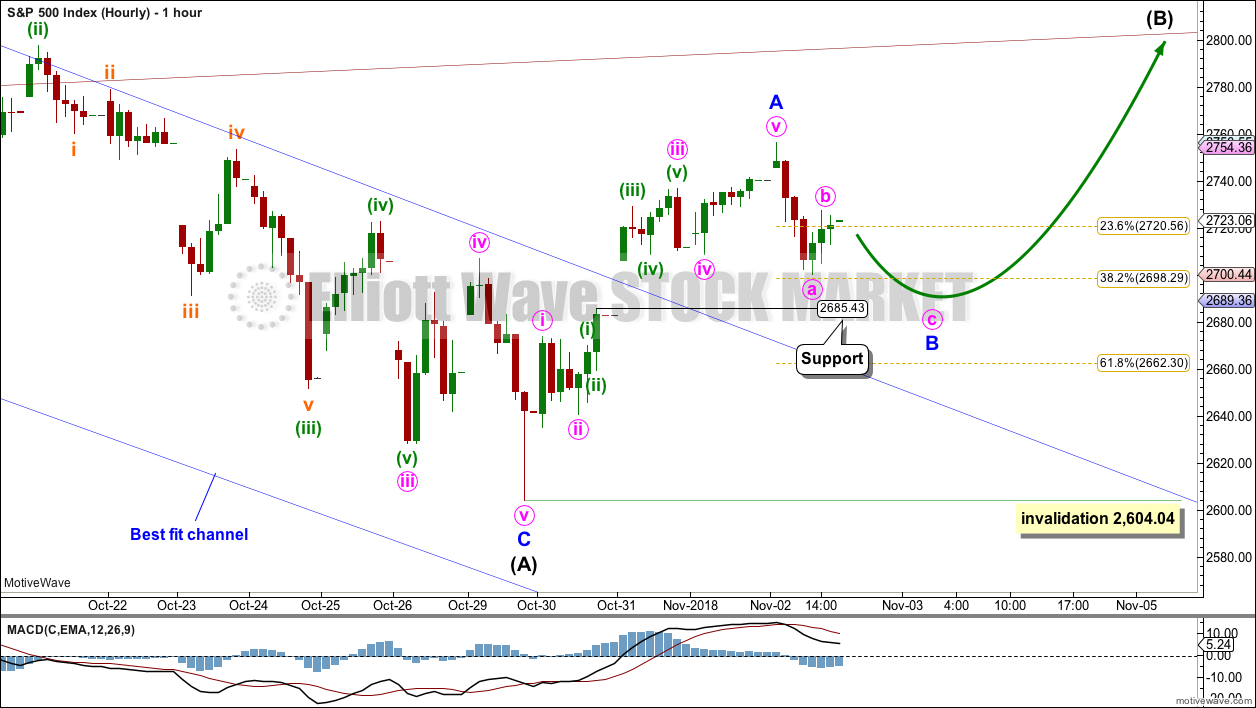

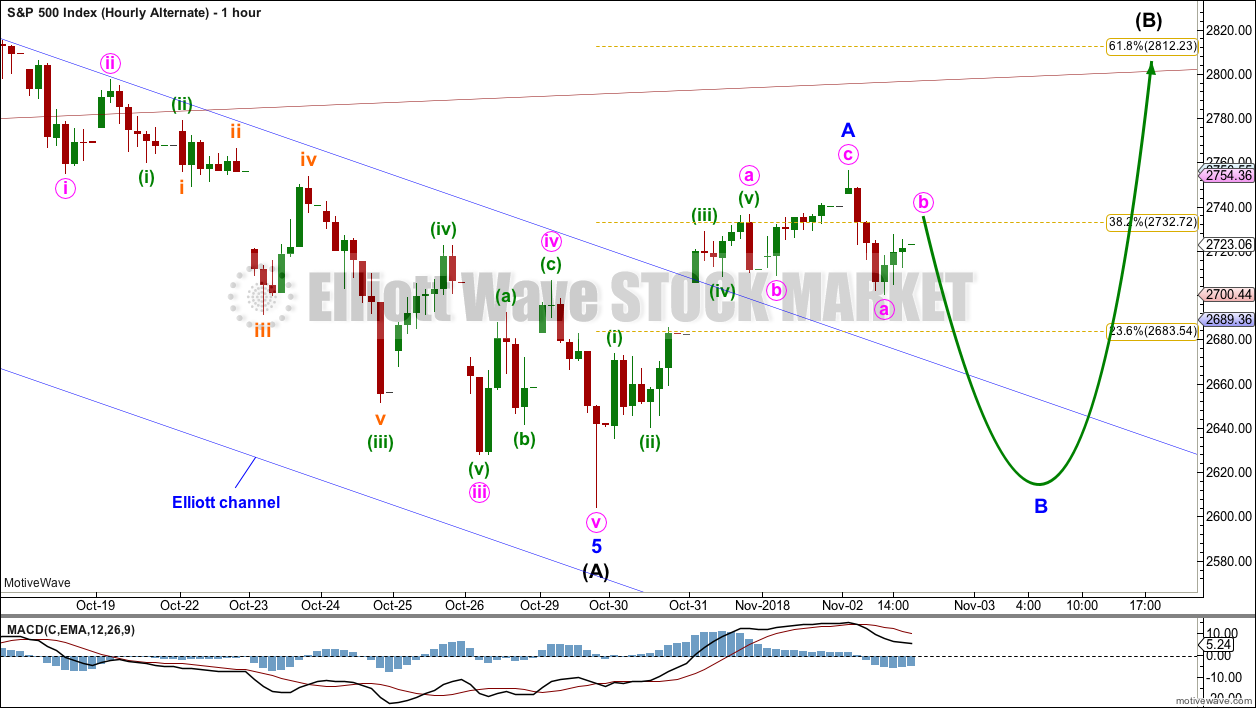
Here’s a tip.
Huge open interest on SPY 275 strike call options for the next two weeks. Lots of traders expecting SPY to be trading above strike on Nov 16 with some 30K+ contracts.
Market makers are going to have to fork over a lot of moolah if they are right and the wave count suggests they well might be. Higher VIX also means higher premiums.
Expect the market makers to ” shake the trees” to dislodge any weak hands. That should result in a SPY move down at least 100
points to around 265, possibly our C wave.
Those 275 strike calls are going to be a lot cheaper when that happens! 😉
Just curious where you get your options open interest information?
I use http://www.opricot.com/ticker/spy/optiongraphs but don’t find it reliable.
CBOE. NASDAQ
Open interest now at almost 100K!
But get this, 270 strike puts now at 177K+!
Traders are expecting fireworks around the pivots! 🙂
I took a small short-term short (friday expiry SPY options) on the hit and stall of the 61.8%. If it breaks above it I’m gone.
Good morning everybody.
It looks like a small double zigzag may be unfolding higher. This looks like a B wave, within a B wave, within a B wave. Three degrees of B wave. We need to be patient and flexible with this. The labelling of it will probably change.
Tri-Beta! 🙂
I’ve been waiting all day… let’s “c” if i can make some money
B waves require patience, and precision…! 🙂
I’m waiting for a manic C wave….
minute C down? or minor C up? or intermediate C down?
lots of C wave’s will be rolling, some in…some out!!
just another manic C wave…… oh, oh, oh…. I hope to ride that wave…. oh, oh, oh
Sing it brother!
Surf’s up! 😀
From a trading psychology viewpoint, there is quite an interesting theme at play. The aim is to violently shake out bearish traders. Traders using substantial leverage will all probably be dislodged, with even generous stops being violently run. This is a hallmark of bear-market price action, as are manic “C” waves. The near term arena for the battle is once again the round numbers of DJIA 25K and SPX 2700. Note how price was violently gapped back above those pivots last Wednesday. Those pivots are psychologically important and may also have huge implications for margin debt. For active traders, those are the levels to watch, and around which short term trades can be confidently executed. While price continues to trade above them the bias is upward or sideways price action. A close below means the banksters are on the run and new lows on the way.
Enjoy your week-end!
Thank you, Verne (also Kevin, Chris, Rodney and others), for your generous insights!
🙂
This sideways action at the hourly TF above 2700 (where a key 38% fibo lies) has now put SPX into a multi-hour squeeze. I’m quite suspicious this one breaks to the down side, but will wait for the market to inform me.
I also am more than a little suspicious Wednesday will be bloodbath (I know the count doesn’t support that). It is a dangerous market; large B waves always are. That also means opportunity, but with higher risks than normal.
I don’t think SPX goes up unless/until NDX at least stabilizes. Perhaps the major down trend line broken last week will serve as support, right around the 50% fibo shown. Hourly chart.
You will have to be faster to take the poll position on a weekend.
#1 for fun.
Rodney the spoiler!
I came down with the flu yesterday, even after getting my flu shot 2 months ago. I guess I’m far less sick that I would be, but that’s small consolation. I’m not doing to much in this market until Wed, so my desire to just lay in bed isn’t a huge problem; as I said last week, I don’t think much will happen until then, either.
I am with you on waiting. Remember Nov. 2016 when the SPX was down over 100 points in overnight trading before it reversed. If I recall properly it was then up something like 100 points the next day. Perhaps we have a repeat. I don’t know. But I am waiting.
Hope you feel top notch soon.